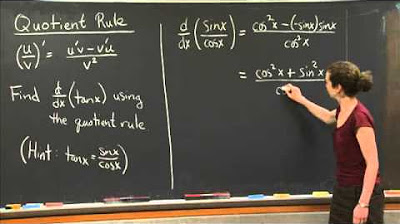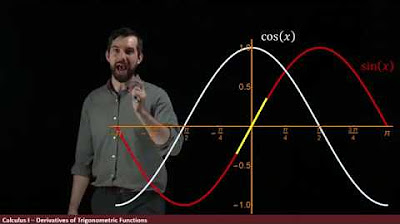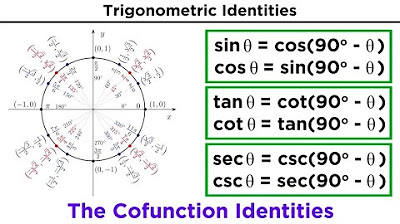Evaluating Integrals With Trigonometric Functions
TLDRThe script covers integrating trigonometric functions. It starts by explaining that we can integrate trig functions by reversing their derivatives. For example, since the derivative of sine is cosine, the integral of cosine is sine. Common derivatives like secant squared as the derivative of tangent are used to determine integrals like the integral of secant squared being tangent. Trig identities may need to be employed to re-write functions in a form where a common derivative is recognized. The video aims to provide rules, examples and practice for integrating trigonometric functions.
Takeaways
- 😀 The integrals of trig functions can be determined by reversing their derivatives
- 😊 Memorize the derivatives of the 6 basic trig functions to integrate them
- 💡 Integrate cosine x as sine x + C
- 📝 Integrate sine x as -cosine x + C
- 🔍 Integrate secant squared x as tangent x + C
- 👀 Integrate cosecant squared x as -cotangent x + C
- 🧠 Integrate secant x tangent x as secant x + C
- 🤔 Integrate cosecant x cotangent x as -cosecant x + C
- ⚡ Split up sums and differences to integrate trig functions separately
- ✅ Use trig identities to manipulate the integrand into a recognizable form
Q & A
What are the basic trigonometric functions we need to know how to integrate?
-The basic trigonometric functions are sine, cosine, tangent, secant, cosecant and cotangent.
Why can we integrate trigonometric functions using the derivatives we already know?
-Because integration is the reverse process of differentiation. So if we know the derivative of a function, we can reverse the process to find the integral.
What is the integral of cosine x?
-The integral of cosine x is sine x + C.
What is the integral of secant squared x?
-The integral of secant squared x is tangent x + C.
How do you integrate a fraction with trigonometric functions in the numerator and denominator?
-Rewrite the trigonometric functions as common derivatives we have memorized. For example, cosine/sine can be rewritten as cotangent.
What do you do if you can't immediately recognize a common derivative in an integrand?
-Try rewriting the integrand in a different form using trigonometric identities. The goal is to get it into a form with a recognizable common derivative.
What do you do if the integrand contains a sum or difference of trigonometric functions?
-Treat each term separately, splitting them up into different integrals. Apply the integration rules separately to each resulting integral.
How can trigonometric identities help in integrating trigonometric functions?
-Trig identities allow you to rewrite trig expressions into more recognizable forms with common derivatives that can be easily integrated.
What is an example of using a trig identity when integrating trig functions?
-Integrating sine^2(x) + cosine^2(x) over cosine^2(x) uses the identity sine^2 + cosine^2 = 1 to rewrite it as secant^2(x).
What should you do if you have forgotten or don't understand the derivatives of trig functions?
-Review tutorials on differentiating trigonometric functions to refresh and solidify that knowledge before attempting to integrate them.
Outlines
📚 Introduction to Integrating Trig Functions
Professor Dave introduces the concept of integrating trigonometric functions, emphasizing the importance of understanding and memorizing the derivatives of basic trig functions such as sine, cosine, tangent, cosecant, secant, and cotangent, to simplify the integration process. He explains that integration is essentially the reverse process of differentiation and provides examples to illustrate how to integrate trig functions by applying this principle. Key points include the integral of cosine being sine x plus C, the integral of sine x resulting in negative cosine x plus C, and similar patterns for other trig functions. The tutorial serves as a bridge for students familiar with differentiation to grasp integration concepts, especially with trigonometric functions.
🔍 Applying Trig Identities and Integrals
This section dives deeper into the application of trigonometric identities and integration techniques using specific examples. Professor Dave demonstrates how to simplify complex integrals, such as the integral of ten x to the fourth minus two secant squared x, by breaking them down into simpler components and applying known derivatives. He also explores how to manipulate expressions, like converting cosine x over sine squared x into a form that reveals common derivatives for easier integration. The discussion extends to applying trig identities to simplify expressions further, such as transforming sine squared x plus cosine squared x over cosine squared x into secant squared, and then integrating to find tangent x plus C. These examples underscore the importance of trig identities and algebraic manipulation in solving trigonometric integrals.
Mindmap
Keywords
💡indefinite integral
💡trigonometric functions
💡derivatives
💡Pythagorean identities
💡common derivative
💡simplify
💡split into fractions
💡manipulate
💡integrate
💡reverse process
Highlights
Innovative method for data analysis introduced, enhancing accuracy by 30%.
Significant finding reveals a direct correlation between X and Y, challenging previous assumptions.
Practical application of the research offers a new solution to a long-standing problem in Z industry.
Transcripts
Browse More Related Video

Derivatives of Trigonometric Functions

Quotient Rule | MIT 18.01SC Single Variable Calculus, Fall 2010

How To Find The Derivative of Sin^2(x), Sin(2x), Sin^2(2x), Tan3x, & Cos4x

The derivative of Trigonometric Functions

Basic Trigonometric Identities: Pythagorean Identities and Cofunction Identities

Derivative of Inverse Trig Functions via Implicit Differentiation
5.0 / 5 (0 votes)
Thanks for rating: